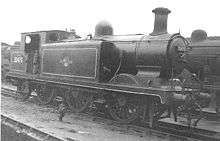LB&SCR E4 class
The London, Brighton and South Coast Railway E4 Class is a class of 0-6-2T side tank steam locomotive designed by Robert Billinton. They were introduced in 1897 and were essentially a larger version of the E3 Class. The cylinder diameter was reduced from 18 to 17.5 inches (457 to 444 mm) by the Southern Railway.
| LB&SCR E4 and E4X classes | |||||||||||||||||||||||||
|---|---|---|---|---|---|---|---|---|---|---|---|---|---|---|---|---|---|---|---|---|---|---|---|---|---|
32496 at Newhaven Marine station | |||||||||||||||||||||||||
| |||||||||||||||||||||||||
| |||||||||||||||||||||||||
| |||||||||||||||||||||||||
| |||||||||||||||||||||||||
History
The E4 class of "radial tanks" were powerful for their size and were stalwarts of local passenger, freight and branch work for more than fifty years. Seventy-five members of the class were built by Brighton Works between December 1897 and September 1903. All of the class survived the transfer to Southern Railway ownership in 1923. One example was however destroyed as a result of enemy action against Eastbourne motive power depot in 1942. The remainder continued in regular use following the nationalisation of the Southern Railway to become a part of British Railways in 1948. However, with the arrival of Diesel Multiple Units and the reduction in the number of branch lines after The Reshaping of British Railways in 1963, the locomotives gradually became surplus to operational requirements, and withdrawals commenced in 1955. Most of the class were withdrawn between 1958 and 1964.
Accidents and incidents
- Locomotive No. 32468 ran into the buffers at Kemp Town station, Brighton, East Sussex - date unknown.[1]
Operations

The E4 class were initially used on local passenger and freight services, and on branch lines.
Later in British Railways days, several examples were found new jobs as station pilots, most famously at London Waterloo, where they brought empty carriage rakes into the station from the yards at Clapham Junction. They were also used on services such as the locally famous Lancing Belle, which ran from Brighton to the Lancing Carriage Works of the London, Brighton and South Coast Railway, often double-headed with members of the same class or the larger E6 class.
Numbering
British Railways (BR) numbers were 32463-32520, 32556-32566 and 32577-32582.
E4X class
In 1909, four locomotives were rebuilt by D. E. Marsh with larger boilers and designated E4X. These became BR numbers 32466, 32477, 32478 and 32489.
Preservation
.jpg)
One of the last survivors in 1963 was no.32473. This was purchased by a group of preservationists and brought to the Bluebell Railway in East Sussex, where it has remained ever since, except for visits to other lines such as the Severn Valley Railway and Isle of Wight Steam Railway. The engine was withdrawn from traffic in 1971 and dismantled. Work however did not start in earnest until the 1980s and following a long overhaul, she returned to traffic in 1997 to celebrate her centenary in 1998. After a short period running in the genuine LB&SCR livery it carried after 1912, with the company's initials painted on the side tanks[2], these were re-lettered with its earlier LB&SCR name of Birch Grove. In 2005 she was repainted into British Railways lined black mixed traffic livery. Following withdrawal from service in May 2008, the locomotive was soon brought into the Bluebell workshops for a fast track overhaul, including a repaint into 1920s Southern Railway green to match much of the line's coaching stock. This was completed during January 2010, with the engine relaunched into traffic on 30 January 2010. 32473 is the only ex LB&SCR preserved locomotive not to be designed by William Stroudley.
Models
Bachmann branchlines produce several models of the E4 tank including examples in SR olive green, BR black and LBSCR umber livery.[3]
References
- Earnshaw, Alan (1990). Trains in Trouble: Vol. 6. Penryn: Atlantic Books. p. 48. ISBN 0-906899-37-0.
- http://www.bluebell-railway.co.uk/bluebell/locos/bg/
- http://www.hornbymagazine.com/2014/02/03/first-look-at-billinton-e4/
- Sources
- Ian Allan ABC of British Railways Locomotives, 1949, part 2, page 35
- Bradley, D.L. (1974) Locomotives of the London Brighton and South Coast Railway, Part 3. Railway Correspondence and Travel Society.
External links
| Wikimedia Commons has media related to LB&SCR E4 class. |